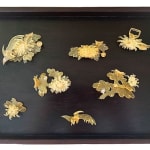


artisan's name unknown
A set of eight pieces from Kamikazari (Hair ornaments), circa 1930
Tortoise shell
Sold
Further images
These were the parts of Kamikazari (hair ornament) from the Taisho Era (1912-1926), worn exclusively on a wedding day. The brilliant composition and complexity of these works are remarkable. Kamikazari...
These were the parts of Kamikazari (hair ornament) from the Taisho Era (1912-1926), worn exclusively on a wedding day.
The brilliant composition and complexity of these works are remarkable.
Kamikazari (hair ornaments) like these were similar to those that adorned the hair of wealthy merchants’ and high-ranking warriors’ daughters during the Edo Period (1603-1898). By the Taisho Era (1912-1926), this type of Kamikazari was only used during one’s wedding.
Interestingly, the many changes in women’s everyday life occurred in the Taisho era(1912 – 1926), while their wedding attire remained unchanged. It reflects how, although the Taisho Era was a time of great change for women, everything about marriage still adhered to old customs, strictly controlled by the family.
An inventive colletor will see many possibilities in this obsolete object.
The work is a remnant of a Kamikazari from around the Taisho Era (1912-1926). The object can be appreciated as an exceptional art piece, detached from its traditional setting in arranged marriages. Its warmth can be embraced elegantly by a wooden or lacquer tray. Alternatively, they could be fashioned into a great broach.
Imagine wearing the piece on a simple black silk dress at your next dinner party.
The brilliant composition and complexity of these works are remarkable.
Kamikazari (hair ornaments) like these were similar to those that adorned the hair of wealthy merchants’ and high-ranking warriors’ daughters during the Edo Period (1603-1898). By the Taisho Era (1912-1926), this type of Kamikazari was only used during one’s wedding.
Interestingly, the many changes in women’s everyday life occurred in the Taisho era(1912 – 1926), while their wedding attire remained unchanged. It reflects how, although the Taisho Era was a time of great change for women, everything about marriage still adhered to old customs, strictly controlled by the family.
An inventive colletor will see many possibilities in this obsolete object.
The work is a remnant of a Kamikazari from around the Taisho Era (1912-1926). The object can be appreciated as an exceptional art piece, detached from its traditional setting in arranged marriages. Its warmth can be embraced elegantly by a wooden or lacquer tray. Alternatively, they could be fashioned into a great broach.
Imagine wearing the piece on a simple black silk dress at your next dinner party.
Signup for our Newsletter
You will receive two emails a month from us. One introduces artworks and design works from Kyoto's hidden sources and the other is stories from Misako, sharing insights into Japanese culture.
* denotes required fields
为了回应您的查询,我们将根据我们的隐私政策处理您提供的个人数据。


